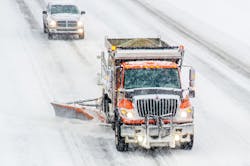Snow removal season is prime time for road maintenance workers.
Venturing out into the bitter, wintry weather in their snowplows or winter maintenance vehicles, crews are tasked with protecting the average citizen from the perils of snowstorms by eliminating snow and ice from major roads and highways. Motorists attempting to brave borderline-blizzard conditions usually have state road maintenance workers to thank for ensuring road safety by responding to harsh winter weather road conditions in a timely manner.
Oftentimes, while routine strategies for winter road maintenance are necessary and accommodating to the average motorist, they also consume inordinate amounts of time and resources for maintenance facilities and state departments of transportation. In order to increase efficiency in road maintenance operations, one facility in the Upper Peninsula (UP) of Michigan has adopted a new lighting system to apply to wing plows attached to its winter maintenance vehicles. These wing plows enable plow drivers to cut down time spent on snow removal and deicing, while the lighting system provides the everyday motorist with a visible signal for a wing plow that is active in a live traffic lane.
A seasonal necessity
The state of Michigan experiences a wide range of annual snowfall averages. Some areas in the Lower Peninsula (LP), the mainland of the Wolverine State, generally withstand 30-40 in. per year. This average shows a stark contrast to the overwhelming flurry totals that pummel its upper counterpart; there are areas in the UP that can experience 300 in. of snowfall in a year, sometimes more, which is nearly 10 times that of some LP areas.
As a result of the overabundance of harsh winter weather, state workers at the L’Anse Maintenance Facility in the UP are out on local roads and highways with winter maintenance machines constantly throughout the winter season.
“Out here in upper Michigan, mother nature is kind of brutal to us with the lake effect snow,” L’Anse Maintenance Supervisor John Dault told Roads & Bridges. “I don’t believe that there’s a day during the course of winter that we don’t have trucks out.” The city of L’Anse experiences average snowfall amounts of 148 in. per year, according to Sperling’s Best Places, in contrast to Detroit’s 32.9 in. and Lansing’s 36 in.
With high levels of snow accumulation, road maintenance workers spend a lot of time out on the roads in the UP. As a result, the cost to maintenance facilities and the Michigan Department of Transportation (MDOT) tends to be pretty high in order to afford treatment for icy road conditions, employee wages and fuel for maintenance vehicles.
MDOT workers first tested the wing-plow lighting system on the shoulders of major roads.
Perfect upgrade for imperfect system
In order to alleviate extra costs, wing plows are added to winter maintenance vehicles, which are typically deployed on the right side of a standard plow truck. These wing plows allow drivers to clear about 14 ft in one pass by extending the plow’s reach. This covers more ground on snowplowing duties than a typical truck without the wing, which would reach only about 9-10 ft.
The problem with wing plows is, since they are extended to the side of a road maintenance vehicle and not in front, they are harder to spot when plowing solo through a live lane, making their implementation potentially dangerous for motorists driving through dense winter weather. According to Mark Geib, MDOT Engineer of Operations Field Services, there have been incidents in the state where motorists, not able to see past the snow, have run into active wing plows in live lanes.
“I do believe we had two or three incidents, none of them were extremely severe, but yes they were hit,” Geib told Roads & Bridges. “I feel with the sheer amount of time we are out there, which is enormous, especially when we’ve had the larger winters, we’ve been pretty lucky to not have anything too severe happen.”
Concerns for public safety prompted MDOT to enact a policy for its maintenance crews to refrain from using wing plows in live traffic lanes. However, since it was clear there was also an advantage to employing wing plows for winter maintenance purposes, members of the L’Anse crew devised an innovative idea to illuminate the wings in order to make the plows visible to motorists approaching them. Tom Deschaine and Jason Rinkinen, both state workers at the L’Anse Facility, developed the Superior Stick lighting system as the solution for wing plow use in the middle of live traffic.
“We needed something to be able to use [the wing plow] in a live lane,” Deschaine told Roads & Bridges. “Our biggest thing was simplicity. We needed something that was attached to the wing, that worked with the wing, and that didn’t rely on air or hydraulics to run it. Jason and myself just kind of came up with some pieces that were laying in our garage, tried them out, put some lights on it, and made a prototype from some recycled materials around the garage. And it went from there.”
The lighting stick is a vertically aligned attachment extending from the end of the wing plow. It moves along with the wing plow, extending and retracting at the same time, warning drivers with its three-bulb Ecco LED strobe light as it projects a variety of flash patterns. According to Deschaine and Rinkinen, the lighting system is bright enough to illuminate the blinding snow swirl that trails behind the plow.
“The actual snow is lighting up like a fireball, so you can see it,” Rinkinen said. “And the stick is up high enough where some of it is sticking out of the swirl itself.”
The Superior Stick lighting system makes wing plows visible amidst the snow swirl produced by plowing. The indicator light on the front of the light tree is visible to the driver in mirror.
Passing the test
After creating the Superior Stick system, the L’Anse maintenance workers decided to put their outside-the-box invention to the test. Though at first not allowed to use the wing plows with the lighting system in live lanes, L’Anse workers began to test it out on the shoulders of major roads during heavier winter conditions, taking pictures from a significant distance behind the trucks in order to prove the system’s potential.
“We put it on the truck and we basically just used it the way we normally use the wing, not in the live lane but on the shoulder, just to make sure it would hold up—that it wouldn’t just fall off the truck right away, or that the bulbs wouldn’t burn out or what have you,” Rinkinen said. “And our supervisor documented the video footage of it going on the road. Basically that’s how we presented it to the state to make it legal for us to use in a live lane.”
Once the L’Anse facility was able to prove the effectiveness of the implement, MDOT approved it for use in regular winter traffic maintenance. “We granted our support, as long as they used the lighting system—and with a caveat that they report back any incidents that they may have or any anomalies at all that would help us in the decision making as to whether we went further with this, or if they found problems that maybe we wouldn’t have originally anticipated,” Geib said. “But I’m happy to say, so far for the most part, things have gone as we’d hoped and as expected. So that’s why we have increased the use to a reasonable degree.”
Expanding use
Moving forward, the use of the Superior Stick expanded from Baraga County (where L’Anse is located) to Mackinac and Houghton counties. According to Dan Weingarten at the MDOT Office of Communications, all MDOT trucks with wing plows in the Superior Region are using the new lighting system.
“I believe there are some other garages in the north of the Lower Peninsula and further south that have started to use this,” Weingarten said. “It’s catching on; we’re starting to hear about it now from other road maintenance people around the state.”
The L’Anse Maintenance Facility has now been using the lighting system for two winter seasons. According to John Dault, his facility’s lighting system has attracted the attention of some transportation officials outside the state of Michigan, as well. “I got a call from Connecticut, and even places that don’t routinely do a lot of snow removal, such as Texas,” Dault said. “I was quite surprised, but people are grabbing onto this—there’s a need out there.”
Ultimately, what the Superior Stick is doing for MDOT is sparing the agency a lot of time and resources by enabling it to safely use wing plows on winter maintenance vehicles. “When we use the wing plow, that’s just one more time a truck doesn’t have to make another pass on that area,” Geib said. “So right there, you’re saving employee time and wages, you’re saving fuel, and you’re saving the wear and tear on the equipment.” Geib added that the quality of service that MDOT road maintenance workers provide to the public has improved as a result of implementing the lighting system, since the wing plows enable plow drivers to clear roads of snow and ice at a more rapid pace.
L’Anse Maintenance Supervisor John Dault presents the Superior Stick at an MDOT conference in March 2015.
A state of innovation
The implementation of this lighting development reflects a statewide industry culture that MDOT is adopting to introduce new, inventive ideas into everyday procedures for fields such as road maintenance.
“L’Anse came up with a really neat idea, and it’s growing—people are using it statewide,” Geib said. “We’ve worked very hard at MDOT on having an innovative culture and for pushing people to be innovative and try new ideas.”
One such new idea to emerge from the mind of MDOT employees is the Southwest Region Stick, an innovation to help winter maintenance trucks remain stable while spreading salt on the roads. According to Geib, MDOT spends about $30 million in salt per year for deicing roads. This invention is meant to help trucks stay on calibration, which will keep them from wasting excessive amounts of salt as they treat the roads.
Only time will tell what game-changing invention MDOT will produce next to improve efficiency in winter road maintenance.


